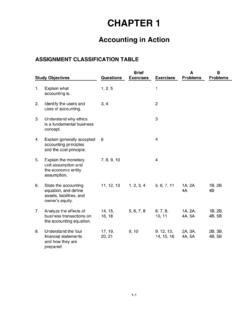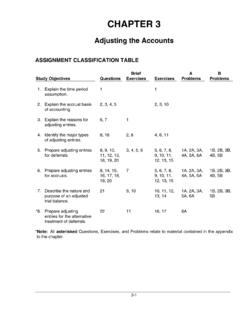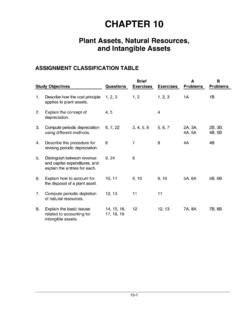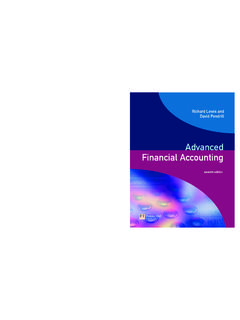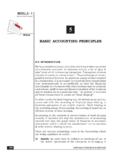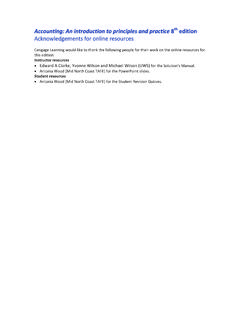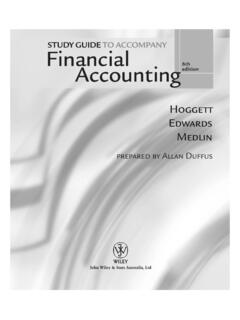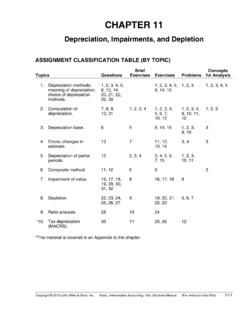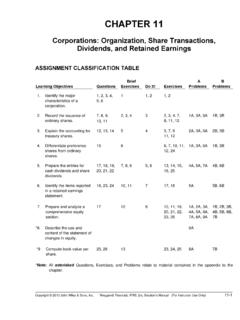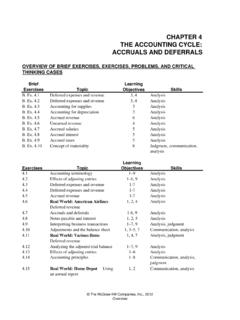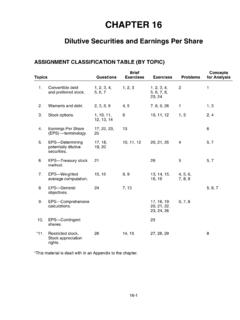Transcription of CHAPTER 4
1 CHAPTER 4. Completing the accounting Cycle ASSIGNMENT CLASSIFICATION TABLE. Brief A B. Study Objectives Questions Exercises Exercises Problems Problems *1. Prepare a worksheet. 1, 2, 3, 1, 2, 3 1, 2, 3, 1A, 2A, 3A, 1B, 2B, 3B, 4, 5 5, 6, 17 4A, 5A 4B, 5B. *2. Explain the process 6, 7, 4, 5, 6 4, 7, 8, 1A, 2A, 3A, 1B, 2B, 3B, of closing the books. 11, 12 11, 19 4A, 5A 4B, 5B. *3. Describe the content and 8, 9 7 4, 7, 8 1A, 2A, 3A, 1B, 2B, 3B, purpose of a post-closing 4A, 5A 4B, 5B. trial balance. *4. State the required steps 10, 11, 12 8 10, 19 5A 5B. in the accounting cycle. *5. Explain the approaches 13 9 12, 13 6A. to preparing correcting entries. *6. Identify the sections of a 14, 15, 16, 10, 11 3, 9, 14 1A, 2A, 3A, 1B, 2B, 3B, classified balance sheet. 17, 18 15, 16, 17 4A, 5A 4B, 5B. *7. Prepare reversing entries. 10, 19, 20 12 18, 19. *Note: All asterisked Questions, Exercises, and Problems relate to material contained in the appendix *to the CHAPTER . 4-1. ASSIGNMENT CHARACTERISTICS TABLE.
2 Problem Difficulty Time Allotted Number Description Level (min.). 1A Prepare worksheet, financial statements, and adjusting Simple 40 50. and closing entries. 2A Complete worksheet; prepare financial statements, Moderate 50 60. closing entries, and post-closing trial balance. 3A Prepare financial statements, closing entries, and post- Moderate 40 50. closing trial balance. 4A Complete worksheet; prepare classified balance sheet, Moderate 50 60. entries, and post-closing trial balance. 5A Complete all steps in accounting cycle. Complex 70 90. 6A Analyze errors and prepare correcting entries and trial Moderate 40 50. balance. 1B Prepare worksheet, financial statements, and adjusting Simple 40 50. and closing entries. 2B Complete worksheet; prepare financial statements, Moderate 50 60. closing entries, and post-closing trial balance. 3B Prepare financial statements, closing entries, and post- Moderate 40 50. closing trial balance. 4B Complete worksheet; prepare classified balance sheet, Moderate 50 60.
3 Entries, and post-closing trial balance. 5B Complete all steps in accounting cycle. Complex 70 90. Comprehensive Problem: Chapters 2 to 4. 4-2. Correlation Chart between Bloom's Taxonomy, Study Objectives and End-of- CHAPTER Exercises and Problems Study Objective Knowledge Comprehension Application Analysis Synthesis Evaluation *1. Prepare a worksheet. BE4-1 Q4-1 E4-1 P4-2B BE4-2 P4-1B. Q4-2 E4-2 P4-3B E4-5 P4-4B. Q4-3 E4-3 E4-6 P4-5B. Q4-4 E4-17 P4-1A. Q4-5 P4-2A P4-4A. BE4-3 P4-3A P4-5A. *2. Explain the process of closing Q4-6 Q4-7 BE4-4 E4-11 E4-19 P4-4B. the books. Q4-11 BE4-5 P4-2A P4-1A P4-5B. Q4-12 BE4-6 P4-3A P4-4A. E4-4 P4-2B P4-5A. E4-7 P4-3B P4-1B. E4-8. BLOOM'S TAXONOMY TABLE. *3. Describe the content and Q4-8 E4-4 P4-3A P4-1A P4-1B. purpose of a post-closing trial Q4-9 E4-7 P4-2B P4-4A P4-4B. balance. BE4-7 E4-8 P4-3B P4-5A P4-5B. P4-2A. *4. State the required steps in Q4-11 Q4-10 E4-19. 4-3. the accounting cycle. Q4-12 E4-10 P4-5A. BE4-8 P4-5B. *5. Explain the approaches to Q4-13 BE4-9.
4 Preparing correcting entries. E4-12. E4-13. P4-6A. *6. Identify the sections of Q4-14 Q4-17 BE4-10 E4-17 P4-1A P4-4B. a classified balance sheet. Q4-15 Q4-18 E4-3 P4-2A P4-4A P4-5B. Q4-16 BE4-11 E4-9 P4-3A P4-5A. E4-15 E4-14 P4-2B P4-1B. E4-16 P4-3B. *7. Prepare reversing entries. Q4-10 Q4-20 E4-18. Q4-19 BE4-12 E4-19. Broadening Your Perspective Communication Financial Reporting All About You Exploring the Web Decision Making Ethics Case Across the Exploring the Organization Web Comparative Analysis ANSWERS TO QUESTIONS. 1. No. A worksheet is not a permanent accounting record. The use of a worksheet is an optional step in the accounting cycle. 2. The worksheet is merely a device used to make it easier to prepare adjusting entries and the financial statements. 3. The amount shown in the adjusted trial balance column for an account equals the account balance in the ledger after adjusting entries have been journalized and posted. 4. The net income of $12,000 will appear in the income statement debit column and the balance sheet credit column.
5 A net loss will appear in the income statement credit column and the balance sheet debit column. 5. Formal financial statements are needed because the columnar data are not properly arranged and classified for statement purposes. For example, a drawing account is listed with assets. 6. (1) (Dr) Individual revenue accounts and (Cr) Income Summary. (2) (Dr) Income Summary and (Cr) Individual expense accounts. (3) (Dr) Income Summary and (Cr) Owner's Capital (for net income). (4) (Dr) Owner's Capital and (Cr) Owner's Drawing. 7. Income Summary is a temporary account that is used in the closing process. The account is debited for expenses and credited for revenues. The difference, either net income or loss, is then closed to the owner's capital account. 8. The post-closing trial balance contains only balance sheet accounts. Its purpose is to prove the equality of the permanent account balances that are carried forward into the next accounting period. 9. The accounts that will not appear in the post-closing trial balance are Depreciation Expense.
6 Jennifer Shaeffer, Drawing; and Service Revenue. 10. A reversing entry is the exact opposite, both in amount and in account titles, of an adjusting entry and is made at the beginning of the new accounting period. Reversing entries are an optional step in the accounting cycle. 11. The steps that involve journalizing are: (1) journalize the transactions, (2) journalize the adjusting entries, and (3) journalize the closing entries. 12. The three trial balances are the: (1) trial balance, (2) adjusted trial balance, and (3) post-closing trial balance. 13. Correcting entries differ from adjusting entries because they: (1) are not a required part of the accounting cycle, (2) may be made at any time, and (3) may affect any combination of accounts. 4-4. Questions CHAPTER 4 (Continued). *14. The standard classifications in a balance sheet are: Assets Liabilities and Owner's Equity Current Assets Current Liabilities Long-term Investments Long-term Liabilities Property, Plant, and Equipment Owner's Equity Intangible Assets *15.
7 A company's operating cycle is the average time required to go from cash to cash in producing revenues. The operating cycle of a company is the average time that it takes to purchase inventory, sell it on account, and then collect cash from customers. *16. Current assets are assets that a company expects to convert to cash or use up in one year. Some companies use a period longer than one year to classify assets and liabilities as current because they have an operating cycle longer than one year. Companies usually list current assets in the order in which they expect to convert them into cash. *17. Long-term investments are generally investments in stocks and bonds of other companies that are normally held for many years. Property, plant, and equipment are assets with relatively long useful lives that a company is currently using in operating the business. *18. (a) The owner's equity section for a corporation is called stockholders' equity. (b) The two accounts and the purpose of each are: (1) Capital stock is used to record invest- ments of assets in the business by the owners (stockholders).
8 (2) Retained earnings is used to record net income retained in the business. *. *19. After reversing entries have been made, the balances will be Interest Payable, zero balance;. Interest Expense, a credit balance. *20. (a) Jan. 10 Salaries Expense .. 8,000. 8,000. Because of the January 1 reversing entry that credited Salaries Expense for $3,500, Salaries Expense will have a debit balance of $4,500 which equals the expense for the current period. (b) Jan. 10 Salaries Payable .. 3,500. Salaries Expense .. 4,500. 8,000. Note that Salaries Expense will again have a debit balance of $4,500. 4-5. SOLUTIONS TO BRIEF EXERCISES. BRIEF EXERCISE 4-1. The steps in using a worksheet are performed in the following sequence: (1) prepare a trial balance on the worksheet, (2) enter adjustment data, (3) enter adjusted balances, (4) extend adjusted balances to appropriate statement columns and (5) total the statement columns, compute net income (loss), and complete the worksheet. Filling in the blanks, the answers are 1, 3, 4, 5, 2.
9 The solution to BRIEF EXERCISE 4-2 is on page 4-7. BRIEF EXERCISE 4-3. Income Statement Balance Sheet Account Dr. Cr. Dr. Cr. Accumulated Depreciation X. Depreciation Expense X. N. Batan, Capital X. N. Batan, Drawing X. Service Revenue X. Supplies X. Accounts Payable X. BRIEF EXERCISE 4-4. Dec. 31 Service Revenue .. 50,000. Income 50,000. 31 Income 31,000. Salaries Expense .. 27,000. Supplies 4,000. 31 Income 19,000. D. Swann, 19,000. 31 D. Swann, Capital .. 2,000. D. Swann, Drawing .. 2,000. 4-6. BRIEF EXERCISE 4-2. LEY COMPANY. Worksheet Adjusted Income Balance Trial Balance Adjustments Trial Balance Statement Sheet Account Titles Dr. Cr. Dr. Cr. Dr. Cr. Dr. Cr. Dr. Cr. 4-7. Prepaid Insurance 3,000 (a) 1,200 1,800 1,800. Service Revenue 58,000 (b) 1,100 59,100 59,100. Salaries Expense 25,000 (c) 800 25,800 25,800. Accounts Receivable (b) 1,100 1,100 1,100. Salaries Payable (c) 800 800 800. Insurance Expense (a) 1,200 1,200 1,200. BRIEF EXERCISE 4-5. Salaries Expense Income Summary Service Revenue 27,000 (2) 27,000 (2) 31,000 (1) 50,000 (1) 50,000 50,000.
10 (3) 19,000. 50,000 50,000. Supplies Expense D. Swann, Capital D. Swann, Drawing 4,000 (2) 4,000 (4) 2,000 30,000 2,000 (4) 2,000. (3) 19,000. Bal. 47,000. BRIEF EXERCISE 4-6. July 31 Green Fee Revenue .. 13,600. Income 13,600. 31 Income Summary .. 10,700. Salaries Expense .. 8,200. Maintenance 2,500. Green Fee Revenue Date Explanation Ref. Debit Credit Balance 7/31 Balance 13,600 13,600. 7/31 Closing entry 13,600 0. Salaries Expense Date Explanation Ref. Debit Credit Balance 7/31 Balance 8,200 8,200. 7/31 Closing entry 8,200 0. 4-8. BRIEF EXERCISE 4-6 (Continued). Maintenance Expense Date Explanation Ref. Debit Credit Balance 7/31 Balance 2,500 2,500. 7/31 Closing entry 2,500 0. BRIEF EXERCISE 4-7. The accounts that will appear in the post-closing trial balance are: Accumulated Depreciation N. Batan, Capital Supplies Accounts Payable BRIEF EXERCISE 4-8. The proper sequencing of the required steps in the accounting cycle is as follows: 1. Analyze business transactions. 2. Journalize the transactions.
